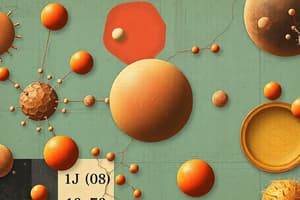Podcast
Questions and Answers
What is the main defining property of lipids?
What is the main defining property of lipids?
- Insolubility in water (correct)
- Solubility in water
- Solubility in polar solvents
- Insolubility in nonpolar solvents
Which component is responsible for the waxy and greasy characteristics of lipids?
Which component is responsible for the waxy and greasy characteristics of lipids?
- Carboxyl group
- Fatty acids (correct)
- Hydrocarbon tails
- Glycerol molecule
What are micelles important for in relation to lipids?
What are micelles important for in relation to lipids?
- Forming cell membranes
- Storing energy
- Providing insulation against the cold
- Transporting insoluble lipids in the blood (correct)
How do saturated and unsaturated fatty acids differ?
How do saturated and unsaturated fatty acids differ?
What is the main function of essential fatty acids like linoleic acid and linolenic acid?
What is the main function of essential fatty acids like linoleic acid and linolenic acid?
What is the main function of bile salts in the digestive system?
What is the main function of bile salts in the digestive system?
What is the structural difference between phosphoglycerides and sphingolipids?
What is the structural difference between phosphoglycerides and sphingolipids?
What is the primary function of cholesterol in the body?
What is the primary function of cholesterol in the body?
How do saturated and unsaturated fatty acids differ in their physical properties?
How do saturated and unsaturated fatty acids differ in their physical properties?
Which of the following is a key characteristic of prostaglandins?
Which of the following is a key characteristic of prostaglandins?
Flashcards are hidden until you start studying
Study Notes
Lipids
- Lipids are biological molecules that are insoluble in water but soluble in nonpolar solvents.
- They have a wide spectrum of compositions and structures defined in terms of physical properties like water solubility.
Characteristics of Lipids
- Lipids are waxy, greasy, oily compounds found in both plants and animals.
- They serve various purposes such as energy storage, structural components (like cell membranes), and insulation against the cold.
Fatty Acids
- Fatty acids are the building blocks of lipids and are responsible for the fatty or oily characteristics of lipids.
- They have long, nonpolar hydrocarbon tails and a hydrophilic carboxyl group.
- Fatty acids can associate in aqueous solutions to form micelles, which are important for transporting insoluble lipids in the blood and the actions of soaps.
- Fatty acids usually have straight chains with 10 to 20 carbon atoms and even numbers of carbon atoms (counting the carboxyl carbon).
- They can be saturated (containing only single bonds) or unsaturated (containing double bonds) with different melting points based on chain length and saturation level.
Essential Fatty Acids
- Essential fatty acids, like linoleic acid and linolenic acid, cannot be synthesized by the body and must be obtained from the diet.
Triglycerides
- Triglycerides are esters composed of three molecules of fatty acids connected to a glycerol molecule, forming a structure called a triglyceride triacylglycerol.
- Hydrolysis breaks down triglycerides into fatty acids and glycerol, while saponification with strong bases forms carboxylate salts of fatty acids like soaps.
Waxes
- Waxes are simple lipids containing fatty acids joined to long-chain alcohols, with higher melting points and hydrophobic properties.
Phosphoglycerides and Sphingolipids
- Phosphoglycerides are major components of cell membranes, related to phospholipids, and contain amino alcohols like choline, ethanolamine, or serine.
- Sphingolipids are complex lipids that contain sphingosine instead of glycerol, with important compounds like sphingomyelins found in nerve tissue.
Glycolipids and Steroids
- Glycolipids are sphingolipids containing carbohydrates and are abundant in brain tissue, sometimes referred to as cerebrosides.
- Steroids are a class of lipids soluble in nonpolar solvents, characterized by a cyclic structure held together by ester linkages.
Cholesterol and Bile Salts
- Cholesterol is an essential component of cell membranes and a precursor to various hormones, but high levels in the blood can lead to atherosclerosis.
- Bile salts help emulsify fats in the digestive system, leading to better digestion, while issues like gallstones can arise from imbalances in bile composition.
Steroid Hormones and Prostaglandins
- Steroid hormones, like sex hormones and glucocorticoids, play important roles in regulating various bodily functions.
- Prostaglandins are cyclic compounds involved in processes like reproduction, blood clotting, and inflammation, with aspirin working to inhibit their production for relief from inflammation and fever.
Fatty Acid Structure
- Most fatty acids found in nature have an even number of C atoms (usually 14-24).
- Fatty acids can be saturated or unsaturated, with mono- or poly-unsaturated bonds.
- Marine organisms have an odd number of fatty acids.
- Fatty acids can be named in at least three ways: Systematic (octadecanoic acid), Common Name (stearic acid), and Symbol (18:0).
- The most common saturated fatty acid in nature is stearic acid (18:0) and palmitic acid (16:0).
- Saturated fatty acids are very flexible due to rotation around each of the C-C bonds.
- Unsaturated fatty acids are slightly more abundant in nature, especially in higher plants.
- Double bonds found in fatty acids are nearly always found in cis configuration, causing a bend or kink in the fatty acid chain.
Studying That Suits You
Use AI to generate personalized quizzes and flashcards to suit your learning preferences.




